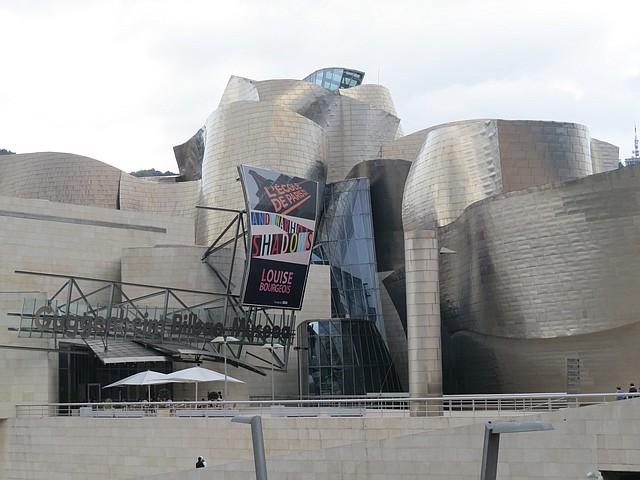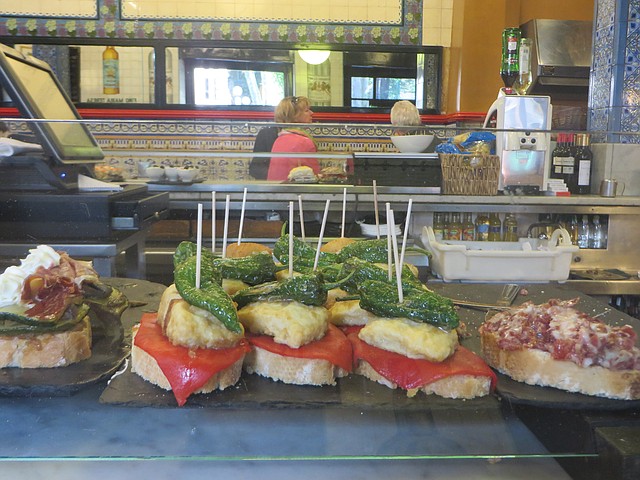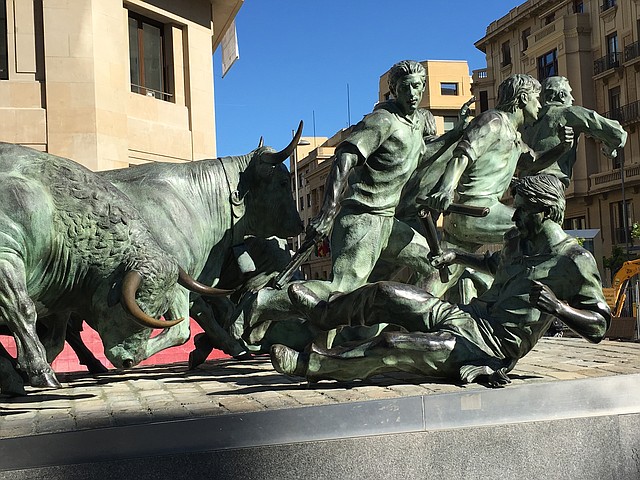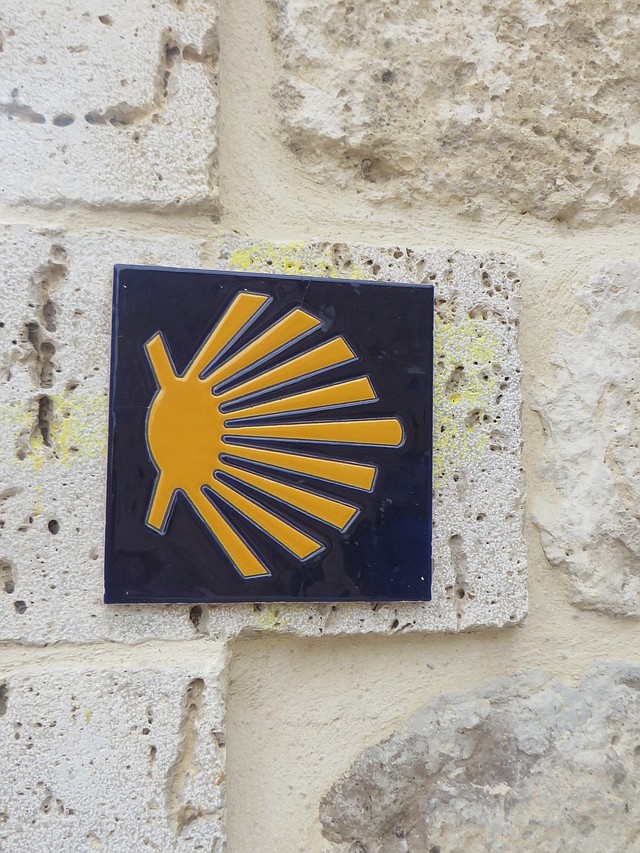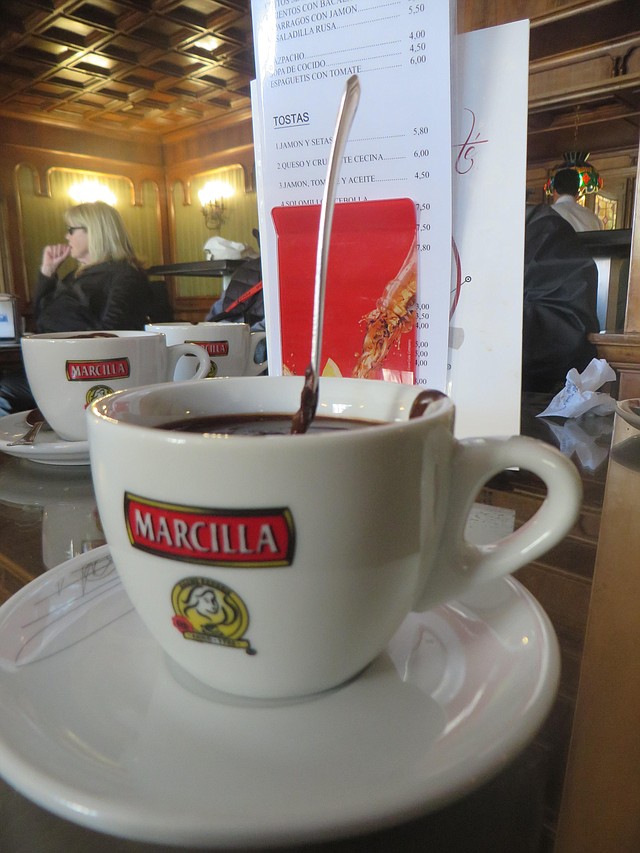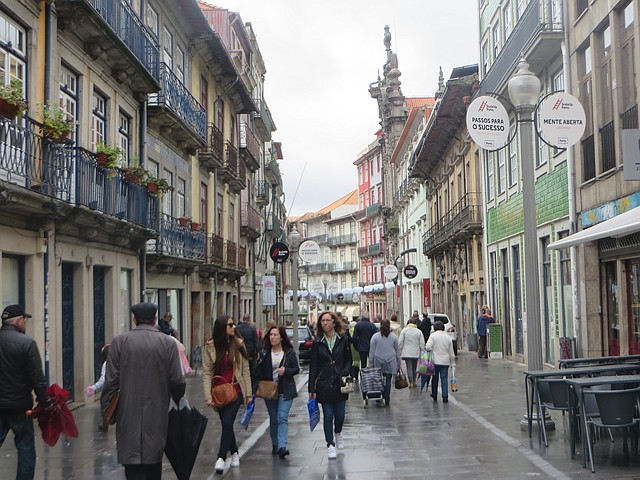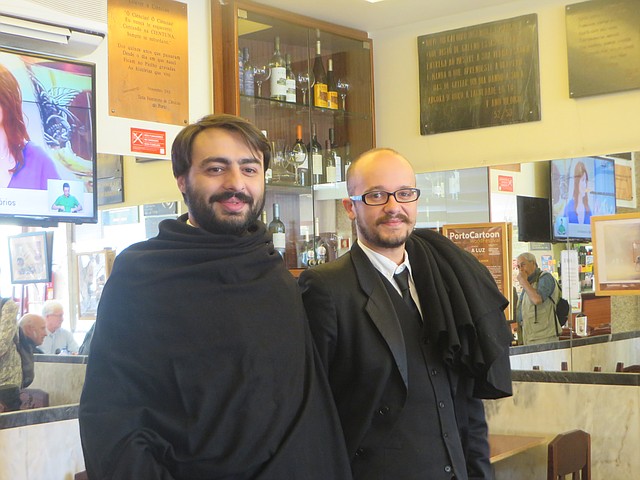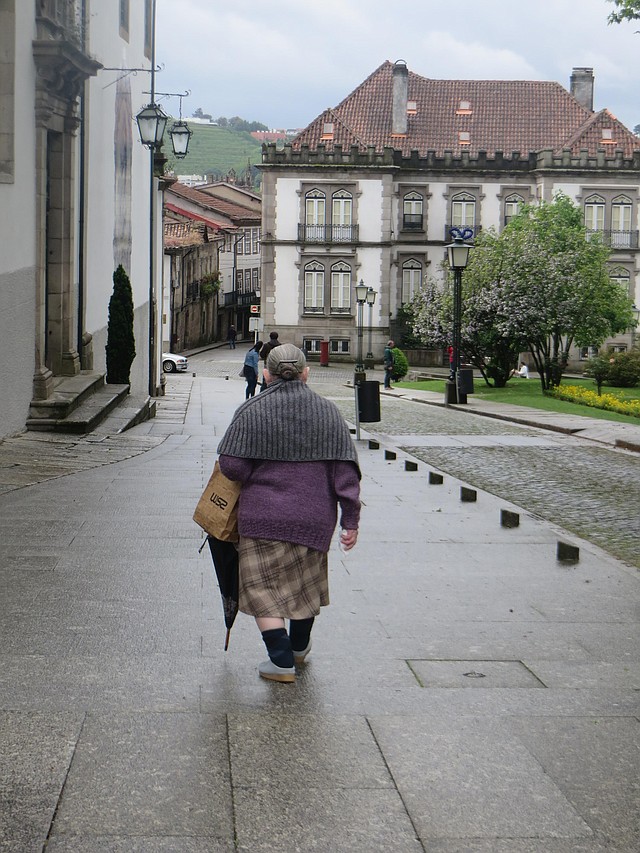Following in the footsteps of pilgrims
June 27, 2016 at 6:00 a.m.
Meet Victoria Oubiña, a resident of the seaside village of Cambados in Northern Spain. She’s a retired marisquera or shellfisher, who had to stop school at nine years old and go to work in order to help her family. Victoria spent 54 years digging for clams and cockles on the beaches of this town and became a face of the local industry, one that is dominated by women in this region. Back in 1992, she and several of her counterparts fought for their rights to organize as a recognized controlled collective and were successful in their efforts. The women, who now number around 200, banded together to clean the beach, plant and replant the native flora and improve soil conditions to aid the clam harvest, solidly restoring an industry that had dwindled in the past. They collect and sell the shellfish as a means of income for their families. Their menfolk are mainly fishermen, who head out to sea on their boats for bigger catches. It’s not an easy life for the women, as it’s backbreaking labor, but they are proud of their work and the fact they can contribute economically.
Meeting Victoria was one of many highlights on my two-week tour to Northern Spain and Portugal with Overseas Adventure Travel (OAT), a highly reputable company that’s widely regarded as the leader in small group tours for adults to destinations “along the road less traveled.” Spending time with a marisquera was an opportunity for our group to get insight into a day in the life of a local resident. Such experiences are part of OAT’s tourism tenets, which emphasize cultural interactions as enrichment tools for tour participants. It’s a boon to travelers, who want to go beyond sightseeing major attractions in an effort to learn more about the culture via personal engagement opportunities.
Another such interaction occurred in the Basque city of Guernica, best known as the scene of the April 26, 1937 “Bombing of Guernica,” one of the first aerial civil bombings by Nazi Germany’s Luftwaffe. The event became the subject of Picasso’s famous antiwar painting of the same name. A replica of the work stands as a reminder and symbol to the Basque people. It was there, in a community center for seniors, that our group had a fascinating discussion on Basque history and culture with a local archaeologist and educator. We also visited a small family-run wine cellar to learn about Tzakoli wine, a Basque favorite. This sparkling dry white wine was once just a homemade product and its production was a local pastime. At the end of the 20th century, however, several vineyards sought and won Designation of Origin certification, which increased Txakoli’s name recognition.
As for food, cod is a mainstay for the Basque people, having once been the major industry in the region. In virtually any bar and restaurant in Northern Spain, you’ll find cod on the menu in some sort of fashion – crispy fried cod skin, cod croquettes, cod stew, or simply a tapa of rehydrated salt cod in olive oil. The fish has certainly left its mark in Basque gastronomy and chefs take personal pride in their culinary arts a la cod.
OAT’s tour, billed as a “Pilgrimage into the Past,” begins in Bilbao, once a major shipbuilding center and the wealthiest city in all of Spain back in 1900. Natural disasters and civil war, however, took its toll on the town and many believed its glory days were in the past. Fortunately, the unveiling of the cutting-edge Guggenheim Museum, designed by Frank Gehry, ignited a transformative boom in the late 1990s and today Bilbao is thriving once again. The museum holds one of the world’s premier collection of contemporary art and is a destination in itself. The futuristic architecture and innovative design of the building with its curved outline and interconnected titanium and limestone-clad spaces is truly unique, and the art within its walls is stunning. It’s no wonder that the place was recently voted “The Most Beautiful Museum in the World 2016” by Condé Nast Traveler readers.
On the way to Pamplona, we stop in San Sebastian, an elegant seaside locale that became known as a destination for the wealthy, attracting politicians, royalty and celebrities. Constitution Square, a massive former bullfighting ring, is a picture-pretty pedestrian plaza ringed by colonnaded buildings; the windows of each which are decorated with the number of the corresponding spectator box that once occupied that particular spot in bullfighting days. We spent time strolling the area and stopped to check out Bretxa Market, one of the oldest continuously operating traditional markets in Spain. It’s a colorful spot with an area designated for Basque certified products, from local veggies and meats to fresh-caught fish. We had the chance to sample a trio of cheeses and later some pinxtos, the Basque answer to tapas. These can be snack-size morsels, some of which are simple and unadorned, while others are miniature works of elaborate cuisine. They are typically eaten accompanied by a couple of glasses of wine.
In Pamplona, the city made famous by the “running of the bulls” event during the yearly San Fermín festival, we discover a charming scene of medieval bridges and buildings dating back to the 14th century. Hemmingway, who visited the town numerous times to witness the running of the bulls, based his renowned book, The Sun Also Rises, on his experiences here, as well as his love of bullfighting, which he deemed “a beautiful nightmare.” There’s a statue of him outside the central ring and you’ll find plenty of places around the city with his moniker. You can even see the room where he stayed in at Hotel La Perla, the second oldest hotel in Spain. The “running of the bulls” happens once daily during the weeklong celebration in July and lasts a mere four to six minutes in duration. The tradition started in the 14th century when handlers took the bulls from the corrals to the bullrings. Each year, 2,000 people participate in this spectacle.
Pamplona is also a major city for pilgrims on the Camino de Santiago or Way of St. James as it is known in English. There are a number of different pilgrimage routes, with the most common being the French route, originating in France. All paths, however, lead to the shrine of the apostle St. James the Great in the Cathedral of Santiago de Compostela in northwestern Spain, where tradition has it that the remains of the saint are buried. Those who undertake this pilgrimage via the French way walk 500 miles over the course of approximately five weeks or more. Last year, more than 240,000 people embarked on this journey. They came from all parts of the world; some making the trek for their second, third or more times. Most walk, though you can do the Camino on a bicycle or even on horseback. Along the route, which is marked with yellow arrows and/or a specific blue and yellow clam shell designation, the pilgrims get their “passports” stamped to document they have gone the distance. This proof is necessary to receive the “compostela” or final certificate at the end, attesting to the fact that one has completed the Camino. Years ago, in the Middle Ages, an actual shell took the place of the certificate, which pilgrims would wear with pride to show they’d been to what they believed to be the end of the world. They envisioned that the end of the way represented the beginning of a new life.
As to why people make the pilgrimage, the reasons vary. There are those who see it as a form of a spiritual path or retreat for their spiritual growth. Others do it for the challenge and adventure, as well as an opportunity to explore the country. We spoke with one young man from Germany who explained to us that being a pilgrim allowed him to leave his comfort zone, while giving him time to think about his next step in life. He highly endorsed the experience, saying it was “addictive” and that he wanted to do it again.
Our group walked several parts of the Camino during the tour. We did one section, beginning in Roncesvalles, a village known as the setting of the defeat of Charlemagne, and another portion on a subsequent day through the tiny, sleepy hamlet of Castrojeriz. The route covers an array of terrain ranging from hilly paths in verdant countryside to flat roads through towns. Along the way, we saw numerous pilgrims and various facilities catering to the walkers.
Before arriving in Santiago de Compostela, we explored the towns of Burgos and León. Burgos is one of Spain’s most well-preserved medieval cities and has the distinction of being a UNESCO World Heritage Site. It’s full of architectural gems from the 14th and 15th centuries, including the renowned Gothic cathedral whose spires “punctuate the skyline like stone exclamation marks,” and the Arco de Santa Maria, the ancient entrance to the city. The cathedral is the heart of the city and took decades to complete. This masterpiece contains more than fifteen different chapels and tombs with elaborate detail. The legendary El Cid is reputed to be buried here and his tomb is in the central nave, occupying the most important place in the cathedral.
León has a long history which is on display in its mix of medieval, Gothic, Renaissance and Modernist architecture. There’s plenty of Roman influence as well due to the fact that the Romans resided in the city for five centuries. You can actually find bronze copies of footprints belonging to Roman soldiers along the streets designating the Roman section of town. Of note is the Cathedral with its dazzling colored windows and the Hostal of San Marcos, an extraordinary historic hotel that once served as a monastery and a hospital. The building dates back to the 16th century and retains its majestic qualities. From the outside, it appears as a magnificent chest with fine carvings.
León is also the site of one of the masterpieces by the Barcelona architect, Antoni Gaudi. The castle-like Casa de Botines, now a bank, is a surprisingly somber-looking building, unlike Gaudi’s other creations. The architect designed only three structures outside of Barcelona. The second is home to an Episcopal palace located in the nearby village of Astorga, which we visited one afternoon. The trip was memorable more so for the hot chocolate we drank, no, ate. Astorga is known for its chocolate, which the explorer Cortez brought with him from Mexico. The hot chocolate we tasted was thick and rich, with the consistency of dark chocolate fondue. You could stick a spoon in it and it would remain upright!
To arrive as the pilgrims do when they enter Santiago de Compostela, we walked in their footsteps as we headed to the famed Cathedral, an 11th century Romanesque edifice with monumental dimensions. It is one of the largest of its kind, presenting an imposing structure that dwarfs everything and everyone in its midst. Inside is a 12th century manuscript that is considered to be the first guide to the Camino in the Middle Ages. The crowds can make touring this place a challenge and if you decide to stay for one of the daily masses, get there early as they close the doors when there’s too many people. Mass is the hottest ticket in town as that’s when the gigantic “Botafumeiro” or thurible is swung, dispensing thick clouds of incense. The Santiago de Compostela Botafumeiro is the largest censer in the world and requires eight men to pull the ropes and bring it into a swinging motion. The custom of a Botafumeiro originated more than 700 years ago and was said to have assisted in masking the stench emanating from hundreds of unwashed pilgrims.
One of my favorite experiences on the tour was the home-hosted lunch in Chaves, a small Portuguese town on the border of Spain and Portugal. Five of our group spent a delightful afternoon enjoying the warm hospitality of Jose Manual, his wife Lenora, and their friend Rose Marie. We munched on a delicious lunch of melon, olives, roasted red peppers, ricotta cheese, homemade vegetable soup, chicken and rice. Though none of our hosts knew much English, we were able to communicate via a combination of other languages including Spanish and French, along with gestures and other body language. Curiosity, a willingness to engage and attempt to use whatever means available to make ourselves understood were all that was needed to break the ice.
Our time in Portugal was spent first in the Douro Valley and later in Porto, the country’s second largest city after Lisbon. The Douro Valley, a UNESCO site, is port wine country with terraced vineyards that rise up alongside the Douro River on quintas or wine farms. This scenic locale is best explored through a visit to one of these farms, or what we would call wineries, to trace the path of port from grape to glass. At Quinta da Pacheca, one of the oldest family owned wineries in the region, we learned about the process involved in making different types of port, as well as red table wines. A cooking class followed where Chef Claudia instructed us in how to make a codfish dish, along with marinated octopus, and for dessert, crème brulee. Food, as you can infer, is an important part of the culture. It ranks third for the Portuguese, coming behind family and football.
Another must-experience while in the Douro Valley is to take a trip down the river on a traditional boat, called a rabelo. It’s a way to experience the beauty of the area from a different perspective, while following the trade routes of the first wine sellers.
Porto, with its 2,000-year-old streets, is a city that begs to be discovered via leisurely strolls. St. Francisco Church, which appears somber from outside with its Gothic exterior, will surprise you when you walk through the doors. The interior is heavily ornate and in the Baroque style with intricate gilt wood carvings. The idea back in the 13th and 14th centuries when the church was built was that gold represented heaven, so the more the better. The Palacio da Bolsa, the city’s 19th century stock market and UNESCO World Heritage Site, is also an elaborate work with individual rooms designed by different artists. A favorite by many visitors is the Moorish-influenced Arab Room with its exquisite tilework.
Porto is full of buildings with charming metal balconies, colorful flowerboxes and facades covered with tiles of every hue imaginable. The town boasts the most beautiful train station in the country, along with the grandest cafe, the Majestic, and the most famous bookstore, Livraria Lello. The latter, due to popularity, requires a ticket for entrance. You’ll understand why when you step inside. It’s like walking into Hogwarts and you half expect Harry Potter and crew to emerge. J.K. Rowlings, author of the well-known series of books, actually lived in Porto for a period of time when she was married to a Portuguese man. Rumor has it she visited the bookstore on occasion and perhaps she used the setting for inspiration.
During our time in Porto, our group had the chance to meet with two university students, José and João. The young men, who were on the final leg of obtaining advanced graduate degrees in architecture, spoke with us about student life and the educational system in Portugal. They also detailed the difficult employment situation for college grads in Portugal and the need to work elsewhere in the European Union due to the country’s continued state of recession. Of interest was the clothing they wore– black suits with black capes. We learned this is the traditional dress of university students, created by students to even out economical differences among them.
A side trip and optional tour to Minho Province provided an opportunity to explore Guimaraes, known as the “cradle of Portugal,” along with Braga, a Roman settlement with a picturesque plaza laid out in the Middle Ages. It’s home to the Archbishop’s Palace, the eleventh-century Braga Cathedral and Bom Jesus do Monte, a fascinating pilgrimage site on a hill just outside the city. You can walk the 654 steps up the Sacred Way to the top or take the funicular. Walking allows you the ability to fully appreciate the series of Baroque staircases laid out in a zigzag shape. A collection of fountains along the way are dedicated to the five senses, while the grounds are filled with attractive gardens, hidden grottoes, miniature chapels and sculptures, making it the perfect sanctuary from everyday life.
In the coming years, it is highly doubtful I will recall all the sights I saw and the names of the places I visited on this tour. What I will always remember though is the rich experiences I had with the people in this part of the world and the insight I gained into their vibrant culture.
For more information about Overseas Adventure Travel and its tours: www.oattravel.com
Deborah Stone is a travel and lifestyle writer, who explores the globe in search of unique destinations and experiences to share with her readers. She’s an avid adventurer who welcomes new opportunities to increase awareness and enthusiasm for travel and cross-cultural connections. Her stories appear in a number of publications as well as on various travel websites. Additionally, she can be frequently be heard dishing travel with the hosts of the NPR-affiliated and AARP produced talk radio show, “2 Boomer Babes.” Deborah is a longtime Seattle area resident, who currently resides in Santa Fe, New Mexico.



